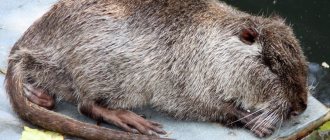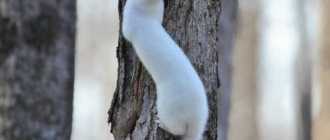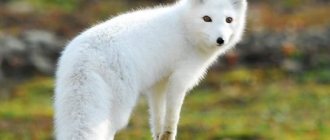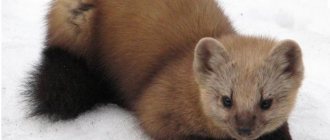The stone marten is considered one of the funniest and most graceful mammals. Another name for the animal is white-haired. It is this particular species of martens that is not afraid of humans and is not afraid to be near people. In its behavior and character traits, the marten resembles a squirrel, although it is a relative of the pine marten. The animal can be found in the park, in the attic of a house, in a barn where poultry is kept. A specific habitat for the stone marten has not been identified, since the mammal can be found on the territory of almost any country.
Appearance
The stone marten (Martes foina) is an animal the size of a small cat or slightly larger. It differs from ferrets, minks and weasels by its short triangular muzzle, large (longer than 3.5 cm) slightly triangular ears, the absence of white on the lower lip and a light spot on the chest. The stone marten is very similar to the pine marten, but its tail is even longer (25-35 cm with a body length of 45-54 cm). This species is characterized by a white throat patch (occasionally light fawn), which is almost always forked below and extends onto the front legs in two stripes.
The general fur color of the stone marten is light, brownish-fawn, with a dark tail and legs. Other differences from the pine marten are the light nose and bare feet. In addition, the stone marten is somewhat smaller, but heavier than its close relative. These animals reach a body length of 40 to 55 cm, and a tail length of 22 to 30 cm. The weight of the stone marten ranges from 1.1 to 2.3 kg. The physique of the stone marten is typical for its genus, with an elongated slender body and relatively short limbs. Her tail is quite long and fluffy.
Kharza
This large predator bears little resemblance to other species of martens. The coloring is bright: a black head with a white chin and reddish cheeks, a bright yellow chest, golden fur on the back, dark brown paws and tail. The coat is short and shiny. The size of the animal ranges from 55 to 80 centimeters, and its weight sometimes reaches 6 kilograms.
Kharza settles in deep forests, away from people. Only females who feed their babies live sedentary. The remaining individuals move freely in search of prey, resting in hollows, crevices, and windbreaks. In addition to small rodents, the harza attacks young deer, wild boars, roe deer and moose. Favorite prey is musk deer. During hunting, animals can unite in groups, which is unusual for other representatives of the species. Another feature of them is their love for honey.
Where do martens live? Kharza inhabits the countries of Asia and the East: China, Korea, India, Pakistan, Afghanistan, Turkey, Nepal, Iran, Georgia, etc. Animals are found in the foothills of the Himalayas, in the taiga and humid tropics, on the ocean coast and in swampy areas. On the territory of Russia, the animals are found in Primorye and the Amur region; they were also brought to Crimea, Adygea and Dagestan.
Subspecies
Biologists have divided all stone martens into four subspecies:
- European white-haired dog. It lives in some areas of the European part of the former Soviet Union and Western Europe.
- Crimean white-haired woman. As is already clear, this is a resident of Crimea. It has a slightly different tooth structure from other relatives, a small skull and a lighter color.
- Caucasian white-haired woman. This is the largest subspecies living in Transcaucasia, having valuable shiny fur and beautiful underfur.
- The Central Asian white-haired woman chose Altai as her place of residence. Her chest spot is poorly developed. Has very lush fur.
Habitat
The stone marten inhabits most of Eurasia, its range stretches from the Iberian Peninsula to Mongolia and the Himalayas. This is the only representative of the genus that does not live exclusively in forests. The stone marten prefers open areas with bushes and isolated trees, often rocky terrain, which is reflected in its name.
In the mountains, this animal is found up to an altitude of 4000 m above sea level. She is not afraid to appear near settlements and is often found in parks, barns and attics. Stone martens are very flexible, agile, fast predators, predominantly nocturnal. They live in nest-dens, which they use all year round for rest, and in severe frosts they spend most of their time in them. The marten makes its den in a rock crack, under stones or roots, in attics, or less often in hollows. They climb trees well, but more often hunt on the ground, mainly at night.
Natural enemies of martens
Photo: Marten in a jump
No matter how versatile warriors pine martens are, in the wild there is a predator for every predator. Dangerous enemies are hawks and golden eagles - you cannot survive against them in their natural environment, that is, in the trees. At night, during hunting, there is a high risk of becoming prey for an eagle owl. And on the ground, foxes, wolves and lynxes wait. Most often, martens are attacked not for food, but to remove a competitor.
Sable can be caught by a bear, a wolf and a fox. But they succeed extremely rarely. The real danger comes from the representative of the mustelids - the harza. An eagle or bald eagle may also attack if given the opportunity. Competitors include stoats, wood grouse, hazel grouse, black grouse, partridge and other birds that eat the berries that the sable feeds on.
Stone martens do not have particularly dangerous enemies. Sometimes wolverines, foxes, leopards or wolves hunt them, but chasing such a nimble and fast animal is quite problematic. More problems may arise with birds: golden eagles, eagles, hawks and, most often, eagle owls.
Kharza is a real killing machine, capable of resisting predators from which other mustelids would prefer to flee. And those who are really able to catch it do not do so because of the specific smell of the meat, which is really very disgusting. But white-breasted bears and tigers sometimes kill these animals.
Lifestyle
Stone martens are active mainly at night, and during the day they hide in their shelters. Their natural shelters are rock crevices, piles of stones and abandoned structures of other animals (stone martens themselves do not build or dig them). Near settlements, stone martens often use attics or stables for this purpose. Nests are lined with hair, feathers or plant material. At night, stone martens go in search of prey, moving mainly on the ground. Although the stone marten can climb trees well, it rarely does so.
Like most martens, stone martens lead a solitary lifestyle and, outside the mating season, avoid contact with their relatives. Each individual has an individual territory, which it marks with a special secret and protects from other stone martens of the same sex. The area of individual sites may vary, but as a rule it is smaller than that of the pine marten. It can range from 12 to 210 hectares and depends, among other things, on gender (the areas of males are larger than those of females), on the time of year (in winter the area is smaller compared to summer) and on the presence of prey in it.
Nutrition
- Nettle
- Elk
- 100 facts about bears
- Jungle animals
- Saber-toothed tiger
- 50 facts about kangaroos
Stone martens are omnivores. They hunt small mammals (rodents, rabbits), birds and their eggs, frogs, insects and others. In summer, an important part of their diet is plant food, which includes berries and fruits. Sometimes stone martens enter chicken coops or dovecotes. The panicky throwing of birds causes a predatory reflex in them, forcing them to kill all possible prey, even if its quantity far exceeds what they are able to eat. Urban martens feed mainly on pigeons, mice and rats that spend the night in attics.
Sable
This strong animal leads a terrestrial lifestyle, climbing trees only in case of danger. The color of sables is varied and very beautiful: from fawn, light brown to almost black. Agile animals settle in the taiga. Dwellings are made in hollows or under tree roots. They feed on plant foods, small rodents, large birds, fish, and attack hares, stoats, and musk deer.
Where do martens of this species live? Sables are the original inhabitants of the Russian taiga. They are found from the Urals to the Pacific Ocean. There are also Japanese sables that inhabit the islands of Tsushima, Shikoku, Kyushu and Honshu. In order to obtain beautiful fur, animals were also brought to the islands of Sado and Hokkaido. Japanese sable can be tan or dark in color with a characteristic light patch on the back of the head.
Martens are a large family that lives in Europe, Asia, and North America. Currently, they can be found in most deep forests of Russia. However, some species are endangered and require special protection.
Reproduction
Martens rut in the summer, but their pregnancy proceeds with a long latent stage, so the cubs appear almost a year later, in late spring. Thus, a full eight months pass between mating and childbirth, while the pregnancy itself lasts only a month. At one time, as a rule, three or four cubs are born (but there can be from 1 to 8), which at the beginning are blind and naked. They begin to see the light on the 30-36th day, begin to emerge from the nest at the age of one and a half months, and the female feeds them with milk for an average of about two months. In the fall, the cubs become independent, and they reach sexual maturity at the age of 15 to 27 months. The average lifespan of stone martens in nature is only three years, the most successful individuals live up to ten years. In captivity, stone martens live much longer and lived up to 18 years.
Species and man
In terms of fur quality, the stone marten is inferior to the forest marten, so its commercial value is small, and it is hunted only where there are no other valuable fur-bearing animals.
In many areas of Western Europe, the stone marten has become a true synanthropic species, and it is not found at all outside human settlements. Here she chooses stables, barns, attics, and basements for housing.
In some areas, the stone marten is considered a pest due to its attacks on chicken coops, dovecotes and rabbit hutches, where in the heat of the hunt it kills significantly more than it can eat. In addition, there are cases where stone martens have “attacked” cars, climbing under the hood and chewing through wires.
Interesting facts from the life of martens
- People hunt stone martens much less often than other species of martens, since their fur is not of particular value due to the coarseness of the hair. But we have to constantly fight them in households.
- Stone martens, eating chickens or getting into a rabbitry, cause great damage, killing all the animals in a row.
- They are great at climbing trees, causing a lot of trouble for birds.
- But, oddly enough, they cause even more harm to cars. Martens are attracted by the smell of the engine, and they chew through the cables and hoses of a car left unattended at night. At the same time, they also put their mark on it, showing their relatives that this is the territory marked by it.
- Therefore, many different means have been created to repel martens. These include repellents and ultrasound.
- The image of a marten appears on the coats of arms of many Russian cities. This is also the mascot of the Salavat Yulaev club, a member of the Kontinental Hockey League.
Video
How do animals reproduce?
In March, representatives of this species begin the mating season. Males scream loudly, making a variety of sounds, and fight over females. Since male weasels are polygamous, they can mate with several individuals of the opposite sex.
After the female becomes pregnant, she is left alone. The male leaves her and lives independently. The period of gestation of cubs lasts up to 35 days. At this time, the female prepares a cozy home for her future babies, which is lined with grass and moss. After 35 days, weasels give birth to tiny blind puppies, weighing about 2 grams .
There can be up to 8 puppies in a litter. While the cubs are blind, and this period lasts three weeks, they drink their mother's milk, but after this period the weasel brings them a small mouse, thereby accustoming them to other food. Then the kids begin to learn to play. They fight, fighting for their first “prey.” 4 months after birth, little weasels leave their mother. When they are about to leave the nest, they follow their mother everywhere. Together with her, they explore the area and go further and further. The reflex of following the mother becomes weaker, and then the matured children begin to live independently.
Relationship with a person
Previously, weasels were hunted for their skins.
Also, in some nations there was a superstition, because of which people were friendly towards affection, and because of their kindness, she seemed to bring happiness to the house. Others believed that it did not bring anything good and avoided the animal. Now the prejudices have evaporated, as has the hunting significance of weasels. She ceased to be an object of extraction of valuable fur. But in large quantities, the weasel exterminates mice, which benefits people . But once she gets into a human home, she will not leave without prey, and will definitely steal something or climb into the chicken coop. Although, due to the extermination of rodents, people are ready to forgive her a lot. Also, keeping this mammal at home has now become popular.
Weasel in your home
With its cute face, the animal wins the hearts of mustelid lovers. These people are eager to have such a pet. does not pose a danger to humans .
If you want to get yourself such a cute predator and become his friend, then you should know that the easiest way to tame a baby. However, they will require care. Difficulties arise with feeding a baby weasel, which is why an adult is usually caught and tamed gradually. Get ready for the fact that the weasel will not accept your idea with enthusiasm, and you will be bitten more than once. Care and attention will do their job: if you are ready to devote time to your future friend, then the weasel can become a faithful pet.
It is difficult to answer the question about purchasing an animal. these animals in a regular pet store , so it’s very difficult to find weasels for sale. Most likely, you will have to catch it yourself or find a special person for this.
What does a weasel look like?











